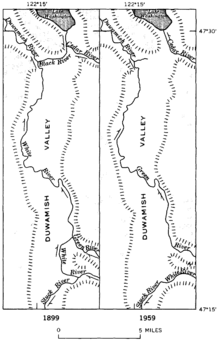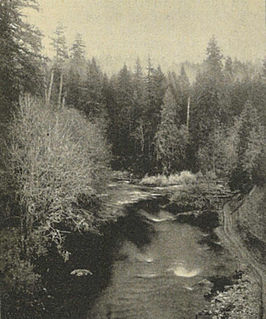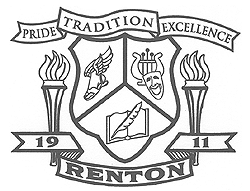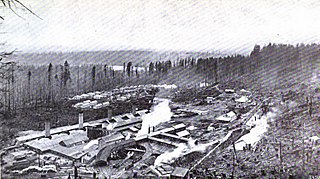

The Black River is a tributary of the Duwamish River in King County in the U.S. state of Washington. It drained Lake Washington until 1916, when the opening of the Lake Washington Ship Canal lowered the lake, causing part of the Black River to dry up. It still exists as a dammed stream about 2 miles (3.2 km) long. [1]

A tributary or affluent is a stream or river that flows into a larger stream or main stem river or a lake. A tributary does not flow directly into a sea or ocean. Tributaries and the main stem river drain the surrounding drainage basin of its surface water and groundwater, leading the water out into an ocean.

The Duwamish River is the name of the lower 12 miles (19 km) of Washington state's Green River. Its industrialized estuary is known as the Duwamish Waterway.

King County is a county located in the U.S. state of Washington. The population was 2,188,649 in the 2017 census estimate. King is the most populous county in Washington, and the 13th-most populous in the United States. The county seat is Seattle, which is the state's largest city.
Contents
Before the 20th century, Lake Washington emptied from its south end into the Black River, which was joined by the Cedar River before meeting the White River (now the lower Green River; the White River has been diverted south). The confluence of the Black and White rivers created the Duwamish River, which emptied into Elliott Bay in Puget Sound. Thus, the water of rivers emptying into Lake Washington, such as the Sammamish River, once flowed through the Black and Duwamish rivers. Today, Lake Washington's water empties into Puget Sound via the Lake Washington Ship Canal. [2]

The Cedar River is a river in the U.S. state of Washington. About 45 miles (72 km) long, it originates in the Cascade Range and flows generally west and northwest, emptying into the southern end of Lake Washington. Its upper watershed is a protected area called the Cedar River Watershed, which provides drinking water for the greater Seattle area.

The White River is a white, glacial river in the U.S. state of Washington. It flows about 75 miles (121 km) from its source, the Emmons Glacier on Mount Rainier, to join the Puyallup River at Sumner. It defines part of the boundary between King and Pierce counties.
In November 1911, the Cedar River flooded Renton. [3] In 1912, the Cedar was diverted from the Black River into Lake Washington to avoid future floods. Its water still flowed through the Black after passing through Lake Washington. In 1916, with the opening of the Lake Washington Ship Canal in Seattle, the lake's level dropped nearly nine feet and the Black River dried up. [4] Today, part of its bed forms the Black River Riparian Forest and Wetland. [5]

Seattle is a seaport city on the West Coast of the United States. It is the seat of King County, Washington. With an estimated 730,000 residents as of 2018, Seattle is the largest city in both the state of Washington and the Pacific Northwest region of North America. According to U.S. Census data released in 2018, the Seattle metropolitan area’s population stands at 3.87 million, and ranks as the 15th largest in the United States. In July 2013, it was the fastest-growing major city in the United States and remained in the Top 5 in May 2015 with an annual growth rate of 2.1%. In July 2016, Seattle was again the fastest-growing major U.S. city, with a 3.1% annual growth rate. Seattle is the northernmost large city in the United States.
The Duwamish people lived along the Black River for many centuries. Duwamish settlements remained along the river until it dried up in 1916. [6] Several indigenous villages were located near the confluence of the Black and Duwamish rivers. The area was called "Inside Place" (Lushootseed: Dxwdəw, from which comes the word "Duwamish"), referring to its location inland from Puget Sound. Long used as a place of refuge, the area became home to many natives displaced by the growing city of Seattle, until the Black River dried up. [7] [8]

The Duwamish are a Lushootseed-speaking Native American tribe in western Washington, and the indigenous people of metropolitan Seattle, where they have been living since the end of the last glacial period. The Duwamish tribe descends from at least two distinct groups from before intense contact with people of European ancestry—the People of the Inside and the People of the Large Lake —and continues to evolve both culturally and ethnically. By historic language, the Duwamish are (Skagit-Nisqually) Lushootseed; Lushootseed is a Salishan language. Adjacent tribes throughout the Puget Sound-Strait of Georgia basin were, and are, interconnected and interrelated, yet distinct. Today, some Duwamish people are enrolled in the federally recognized Tulalip Tribes of Washington.
Lushootseed is the language or dialect continuum of several Salish Native American tribes of modern-day Washington state. Lushootseed is one of the Coast Salish languages. The latter is one of two main divisions of the Salishan language family.















